All Exams >
Grade 4 >
Science for Grade 4 >
All Questions
All questions of Plants for Grade 4 Exam
In radish, food is stored in- a)leaves.
- b)stems.
- c)roots.
- d)flowers.
Correct answer is option 'C'. Can you explain this answer?
In radish, food is stored in
a)
leaves.
b)
stems.
c)
roots.
d)
flowers.
|
|
Pranav Singh answered |
- In radish, food is stored in roots.
- Raddish, Beetroot, Carrot are some more examples of plants in which food is stored in roots.
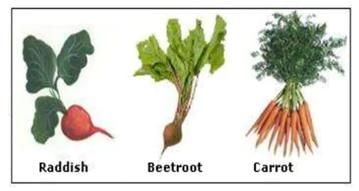
Plants in hilly areas have to bear high speed winds and cold. Which of the following adaptations best helps them face the above conditions?- a)Having lots of branches and leaves
- b)Tall and straight trunk with needle like leaves
- c)Leaves which are modified into spines
- d)Breathing roots which come above the ground
Correct answer is option 'B'. Can you explain this answer?
Plants in hilly areas have to bear high speed winds and cold. Which of the following adaptations best helps them face the above conditions?
a)
Having lots of branches and leaves
b)
Tall and straight trunk with needle like leaves
c)
Leaves which are modified into spines
d)
Breathing roots which come above the ground
|
|
Sudhir Mehta answered |
The trees that grow in hilly areas have needle like leaves, which are very tough and can survive in the cold, snow and wind.
Ramu brought a plant with thick branches and leaves from the plains and planted it in a marshy area. What must the new plant do to survive in its new environment?- a)It must change its colour in its new environment.
- b)It must change its leaves into spines to reduce the loss of water.
- c)It must start trapping insects and eat them.
- d)It must develop breathing roots to get more air.
Correct answer is option 'D'. Can you explain this answer?
Ramu brought a plant with thick branches and leaves from the plains and planted it in a marshy area. What must the new plant do to survive in its new environment?
a)
It must change its colour in its new environment.
b)
It must change its leaves into spines to reduce the loss of water.
c)
It must start trapping insects and eat them.
d)
It must develop breathing roots to get more air.
|
|
Sudhir Mehta answered |
In marshy areas, soil does not contain air. To adjust to marshy conditions, the plant should develop breathing roots.
Plants give out water through the pores present on the lower side of their leaves. Plants living in deserts need to reduce the loss of water because water is very scarce in deserts. Which of the following is an adaptation developed by the desert plants to manage the above situation?
- a)They have lots of branches and leaves.
- b)They do not shed leaves in the summer.
- c)They develop roots which come above the ground.
- d)Their leaves are modified into spines.
Correct answer is option 'D'. Can you explain this answer?
Plants give out water through the pores present on the lower side of their leaves. Plants living in deserts need to reduce the loss of water because water is very scarce in deserts. Which of the following is an adaptation developed by the desert plants to manage the above situation?
a)
They have lots of branches and leaves.
b)
They do not shed leaves in the summer.
c)
They develop roots which come above the ground.
d)
Their leaves are modified into spines.
|
|
Sudhir Mehta answered |
Desert plants have adapted to their environment to minimize water loss. One common adaptation is the modification of leaves into spines. This reduces the surface area through which water can be lost, significantly decreasing transpiration.
Therefore, the correct adaptation developed by desert plants to manage water loss is: Their leaves are modified into spines.
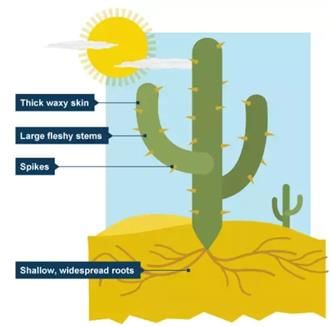

Which characteristic is typical of evergreen trees?- a)Keeping their leaves all year round
- b)Changing leaf color every season
- c)Growing only in tropical regions
- d)Shedding all leaves in winter
Correct answer is option 'A'. Can you explain this answer?
Which characteristic is typical of evergreen trees?
a)
Keeping their leaves all year round
b)
Changing leaf color every season
c)
Growing only in tropical regions
d)
Shedding all leaves in winter

|
Nclex Coaching Centre answered |
Evergreen trees retain their leaves throughout the year, allowing them to photosynthesize continuously. This is in contrast to deciduous trees, which shed their leaves annually to conserve energy during unfavorable seasons.
The plants that are most useful to man are- a)hilly plants.
- b)underwater plants.
- c)desert plants.
- d)plants of the grass family.
Correct answer is option 'D'. Can you explain this answer?
The plants that are most useful to man are
a)
hilly plants.
b)
underwater plants.
c)
desert plants.
d)
plants of the grass family.
|
|
Sudhir Mehta answered |
Plants of the grass family provide us with cereals, hence they are most useful to us.
Trees that do not lose their leaves in winter are called _____. - a) Deciduous
- b) Evergreen
- c) Coniferous
- d) Seasonal
Correct answer is option 'B'. Can you explain this answer?
Trees that do not lose their leaves in winter are called _____.
a)
Deciduous
b)
Evergreen
c)
Coniferous
d)
Seasonal

|
Kds Coaching answered |
Evergreen trees keep their leaves all year long. This helps them stay green and healthy, even when the weather changes.
Which of the following plants does not need soil to grow?- a)Cactus
- b)Fern
- c)Water hyacinth
- d)Pitcher plant
Correct answer is option 'C'. Can you explain this answer?
Which of the following plants does not need soil to grow?
a)
Cactus
b)
Fern
c)
Water hyacinth
d)
Pitcher plant
|
|
Sudhir Mehta answered |
Water hyacinth is an aquatic plant.
What is a major difference between parasitic and insectivorous plants?- a)Parasitic plants do not perform photosynthesis, while insectivorous plants do
- b)Insectivorous plants do not perform photosynthesis, while parasitic plants do
- c)Parasitic plants trap insects, while insectivorous plants do not
- d)Insectivorous plants obtain nutrients from other plants, while parasitic plants do not
Correct answer is option 'A'. Can you explain this answer?
a)
Parasitic plants do not perform photosynthesis, while insectivorous plants do
b)
Insectivorous plants do not perform photosynthesis, while parasitic plants do
c)
Parasitic plants trap insects, while insectivorous plants do not
d)
Insectivorous plants obtain nutrients from other plants, while parasitic plants do not
|
|
Sravya Patel answered |
Understanding Parasitic and Insectivorous Plants
Parasitic and insectivorous plants are two unique types of plants that have adapted to obtain nutrients in different ways.
Main Difference
- Photosynthesis Capability
- Parasitic plants typically do not perform photosynthesis. They rely on other plants for nutrients by attaching to their hosts and extracting water and nutrients directly from them.
- In contrast, insectivorous plants can perform photosynthesis. They have chlorophyll and can create their food using sunlight, just like most plants do.
Characteristics of Parasitic Plants
- Dependency on Host Plants
- They depend entirely on other plants for survival.
- Examples include mistletoe and dodder, which extract nutrients from their host plants.
- Lack of Photosynthesis
- Many parasitic plants have lost the ability to photosynthesize due to their reliance on host plants.
Characteristics of Insectivorous Plants
- Nutrient Acquisition Through Insects
- These plants trap insects to supplement their nutrient intake, especially nitrogen, which is often limited in their environments.
- Examples include Venus flytrap and pitcher plants.
- Ability to Photosynthesize
- Insectivorous plants still perform photosynthesis, allowing them to generate energy independently from the insects they consume.
Conclusion
In summary, the major difference is that parasitic plants do not perform photosynthesis, while insectivorous plants do. This distinction highlights the unique adaptations these plants have made to survive in their respective environments.
Parasitic and insectivorous plants are two unique types of plants that have adapted to obtain nutrients in different ways.
Main Difference
- Photosynthesis Capability
- Parasitic plants typically do not perform photosynthesis. They rely on other plants for nutrients by attaching to their hosts and extracting water and nutrients directly from them.
- In contrast, insectivorous plants can perform photosynthesis. They have chlorophyll and can create their food using sunlight, just like most plants do.
Characteristics of Parasitic Plants
- Dependency on Host Plants
- They depend entirely on other plants for survival.
- Examples include mistletoe and dodder, which extract nutrients from their host plants.
- Lack of Photosynthesis
- Many parasitic plants have lost the ability to photosynthesize due to their reliance on host plants.
Characteristics of Insectivorous Plants
- Nutrient Acquisition Through Insects
- These plants trap insects to supplement their nutrient intake, especially nitrogen, which is often limited in their environments.
- Examples include Venus flytrap and pitcher plants.
- Ability to Photosynthesize
- Insectivorous plants still perform photosynthesis, allowing them to generate energy independently from the insects they consume.
Conclusion
In summary, the major difference is that parasitic plants do not perform photosynthesis, while insectivorous plants do. This distinction highlights the unique adaptations these plants have made to survive in their respective environments.
Which of the following is used to test the presence of starch?- a)Iodine solution
- b)Copper sulphate solution
- c)Potassium hydroxide
- d)Alcohol
Correct answer is option 'A'. Can you explain this answer?
Which of the following is used to test the presence of starch?
a)
Iodine solution
b)
Copper sulphate solution
c)
Potassium hydroxide
d)
Alcohol
|
|
Sudhir Mehta answered |
- Starch turns blue-black when iodine solution is added to it.
- If we add Iodine Solution to Peeled Potato which is a starch, The peeled Potato turns blue- black.
- This confirms the presence of starch in potato.
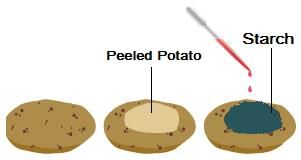
How do parasitic plants obtain their nutrients?- a)By performing photosynthesis
- b)By trapping insects
- c)By absorbing nutrients from other plants
- d)By absorbing nutrients from the soil
Correct answer is option 'C'. Can you explain this answer?
a)
By performing photosynthesis
b)
By trapping insects
c)
By absorbing nutrients from other plants
d)
By absorbing nutrients from the soil
|
|
Rohit Malik answered |
Understanding Parasitic Plants
Parasitic plants are unique organisms that have evolved to thrive by obtaining nutrients from other plants rather than from the soil. This adaptation allows them to survive in environments where resources are limited.
How Parasitic Plants Obtain Nutrients
- Absorbing Nutrients from Hosts:
Parasitic plants attach themselves to host plants through specialized structures called haustoria. These haustoria penetrate the host's tissues, allowing the parasite to directly draw water and nutrients.
- Types of Parasitic Plants:
There are two main types of parasitic plants:
- Holoparasites: These plants are completely dependent on their host for survival and typically do not perform photosynthesis. They obtain all their nutrients from the host.
- Hemiparasites: These plants can perform photosynthesis but still rely on their host for water and certain nutrients, making them partially dependent.
Why Photosynthesis is Not a Primary Method
- Limited Photosynthesis:
While some parasitic plants can photosynthesize, their primary method of nutrient acquisition remains parasitism. They often grow in shaded or nutrient-poor environments where sunlight is limited, reducing their ability to rely solely on photosynthesis.
- Advantage of Parasitism:
By tapping into the nutrient-rich xylem and phloem of host plants, parasitic plants can thrive without competing for soil nutrients, which can be especially beneficial in challenging environments.
Conclusion
In summary, parasitic plants primarily obtain their nutrients by absorbing them from other plants, making option 'C' the correct answer. This fascinating adaptation enables them to survive in various ecological niches, showcasing the diversity of plant life.
Parasitic plants are unique organisms that have evolved to thrive by obtaining nutrients from other plants rather than from the soil. This adaptation allows them to survive in environments where resources are limited.
How Parasitic Plants Obtain Nutrients
- Absorbing Nutrients from Hosts:
Parasitic plants attach themselves to host plants through specialized structures called haustoria. These haustoria penetrate the host's tissues, allowing the parasite to directly draw water and nutrients.
- Types of Parasitic Plants:
There are two main types of parasitic plants:
- Holoparasites: These plants are completely dependent on their host for survival and typically do not perform photosynthesis. They obtain all their nutrients from the host.
- Hemiparasites: These plants can perform photosynthesis but still rely on their host for water and certain nutrients, making them partially dependent.
Why Photosynthesis is Not a Primary Method
- Limited Photosynthesis:
While some parasitic plants can photosynthesize, their primary method of nutrient acquisition remains parasitism. They often grow in shaded or nutrient-poor environments where sunlight is limited, reducing their ability to rely solely on photosynthesis.
- Advantage of Parasitism:
By tapping into the nutrient-rich xylem and phloem of host plants, parasitic plants can thrive without competing for soil nutrients, which can be especially beneficial in challenging environments.
Conclusion
In summary, parasitic plants primarily obtain their nutrients by absorbing them from other plants, making option 'C' the correct answer. This fascinating adaptation enables them to survive in various ecological niches, showcasing the diversity of plant life.
How do plants like cacti adapt to their environment to survive in arid conditions?- a)By having broad leaves to collect more sunlight
- b)By storing water in their stems
- c)By growing long roots to reach deep water sources
- d)By having brightly colored flowers to attract pollinators
Correct answer is option 'B'. Can you explain this answer?
a)
By having broad leaves to collect more sunlight
b)
By storing water in their stems
c)
By growing long roots to reach deep water sources
d)
By having brightly colored flowers to attract pollinators
|
|
Shalini Reddy answered |
Adaptations of Cacti in Arid Conditions
Cacti are remarkable plants that thrive in dry, arid environments where water is scarce. Their unique adaptations allow them to survive and even flourish under such challenging conditions.
Water Storage
- Cacti have specialized stems that can store large amounts of water.
- The thick, fleshy stems act like water reservoirs, allowing the plant to draw on this stored water during long periods of drought.
Modified Leaves
- Instead of broad leaves, cacti have spines.
- Spines reduce water loss by minimizing the surface area that is exposed to the sun and air, which helps to prevent evaporation.
Root System
- Cacti often have extensive root systems that can be shallow and spread out to catch water from light rains.
- Some species also develop deep roots to access groundwater, but the primary adaptation is their efficient use of surface moisture.
Photosynthesis
- Cacti utilize a unique form of photosynthesis called CAM (Crassulacean Acid Metabolism).
- This method allows them to open their stomata at night, reducing water loss while still taking in carbon dioxide for photosynthesis.
Conclusion
These adaptations make cacti perfectly suited for their arid habitats, helping them conserve water and survive harsh environmental conditions. By storing water in their stems, they ensure they have a reservoir to rely on during dry spells.
Cacti are remarkable plants that thrive in dry, arid environments where water is scarce. Their unique adaptations allow them to survive and even flourish under such challenging conditions.
Water Storage
- Cacti have specialized stems that can store large amounts of water.
- The thick, fleshy stems act like water reservoirs, allowing the plant to draw on this stored water during long periods of drought.
Modified Leaves
- Instead of broad leaves, cacti have spines.
- Spines reduce water loss by minimizing the surface area that is exposed to the sun and air, which helps to prevent evaporation.
Root System
- Cacti often have extensive root systems that can be shallow and spread out to catch water from light rains.
- Some species also develop deep roots to access groundwater, but the primary adaptation is their efficient use of surface moisture.
Photosynthesis
- Cacti utilize a unique form of photosynthesis called CAM (Crassulacean Acid Metabolism).
- This method allows them to open their stomata at night, reducing water loss while still taking in carbon dioxide for photosynthesis.
Conclusion
These adaptations make cacti perfectly suited for their arid habitats, helping them conserve water and survive harsh environmental conditions. By storing water in their stems, they ensure they have a reservoir to rely on during dry spells.
Which of the following structures of plant exchanges gases?- a)Buds
- b)Fruits
- c)Leaves
- d)Flowers
Correct answer is option 'C'. Can you explain this answer?
Which of the following structures of plant exchanges gases?
a)
Buds
b)
Fruits
c)
Leaves
d)
Flowers
|
|
Pranav Singh answered |
- Leaves have tiny pores called stomata.
- Through the stomata the exchange of gases takes place.
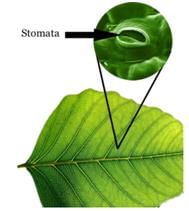
Why do leaves of some plants like the Pitcher plant have modified structures?- a)To store water for long periods
- b)To attract pollinators with bright colors
- c)To trap and digest insects for additional nutrients
- d)To produce extra food for the plant
Correct answer is option 'C'. Can you explain this answer?
a)
To store water for long periods
b)
To attract pollinators with bright colors
c)
To trap and digest insects for additional nutrients
d)
To produce extra food for the plant
|
|
Kaavya Bose answered |
Modified structures of Pitcher plant leaves
Pitcher plants, like many other carnivorous plants, have modified structures on their leaves to aid in trapping and digesting insects for additional nutrients. These modifications serve specific purposes that help the plant thrive in environments where nutrients are limited.
Trapping mechanism
The pitcher plant's leaves are shaped like a pitcher, hence the name, with a deep cavity that contains a fluid filled with digestive enzymes. This structure allows the plant to attract, trap, and digest insects that fall into the pitcher. The slippery walls of the pitcher prevent insects from escaping once they enter, leading to their eventual digestion.
Additional nutrient source
Pitcher plants grow in nutrient-poor environments, such as bogs and marshes, where the soil lacks essential nutrients like nitrogen. By trapping and digesting insects, the pitcher plant can obtain the nutrients it needs to supplement its diet. This carnivorous behavior helps the plant survive and thrive in habitats where other plants may struggle to obtain enough nutrients.
Adaptation to environment
The modified structures of pitcher plant leaves are an adaptation to the plant's environment. The ability to capture and digest insects gives the plant a competitive advantage in nutrient-poor soils. This unique strategy allows the pitcher plant to thrive in habitats where traditional methods of obtaining nutrients, such as through the soil, may not be sufficient.
In conclusion, the modified structures of pitcher plant leaves, specifically the pitcher-shaped cavity with digestive fluid, serve the important function of trapping and digesting insects for additional nutrients. This adaptation helps the plant survive in nutrient-poor environments and demonstrates the remarkable diversity of strategies that plants have evolved to thrive in challenging conditions.
Pitcher plants, like many other carnivorous plants, have modified structures on their leaves to aid in trapping and digesting insects for additional nutrients. These modifications serve specific purposes that help the plant thrive in environments where nutrients are limited.
Trapping mechanism
The pitcher plant's leaves are shaped like a pitcher, hence the name, with a deep cavity that contains a fluid filled with digestive enzymes. This structure allows the plant to attract, trap, and digest insects that fall into the pitcher. The slippery walls of the pitcher prevent insects from escaping once they enter, leading to their eventual digestion.
Additional nutrient source
Pitcher plants grow in nutrient-poor environments, such as bogs and marshes, where the soil lacks essential nutrients like nitrogen. By trapping and digesting insects, the pitcher plant can obtain the nutrients it needs to supplement its diet. This carnivorous behavior helps the plant survive and thrive in habitats where other plants may struggle to obtain enough nutrients.
Adaptation to environment
The modified structures of pitcher plant leaves are an adaptation to the plant's environment. The ability to capture and digest insects gives the plant a competitive advantage in nutrient-poor soils. This unique strategy allows the pitcher plant to thrive in habitats where traditional methods of obtaining nutrients, such as through the soil, may not be sufficient.
In conclusion, the modified structures of pitcher plant leaves, specifically the pitcher-shaped cavity with digestive fluid, serve the important function of trapping and digesting insects for additional nutrients. This adaptation helps the plant survive in nutrient-poor environments and demonstrates the remarkable diversity of strategies that plants have evolved to thrive in challenging conditions.
Why do animals depend on plants?- a)For making food
- b)For giving out oxygen
- c)For providing shelter
- d)For dispersing seeds
Correct answer is option 'B'. Can you explain this answer?
Why do animals depend on plants?
a)
For making food
b)
For giving out oxygen
c)
For providing shelter
d)
For dispersing seeds
|
|
Riya Singh answered |
Animals depend on plants because plants give out oxygen which animals need to breathe. Just like how we need air to live, animals need the oxygen from plants to survive. So, plants and animals help each other to stay alive!
State whether the following statement is True or False:Plants make their own food in a process called photosynthesis.- a)True
- b)False
Correct answer is option 'A'. Can you explain this answer?
State whether the following statement is True or False:
Plants make their own food in a process called photosynthesis.
a)
True
b)
False
|
|
Gargi Chauhan answered |
Understanding Photosynthesis
Photosynthesis is the remarkable process by which plants convert light energy into chemical energy. This process enables them to produce their own food, making the statement true. Here’s a breakdown of how it works:
Key Components of Photosynthesis
- Light Energy: Plants absorb sunlight through their leaves.
- Chlorophyll: This green pigment found in leaves captures sunlight.
- Water and Carbon Dioxide: Plants take in water from the soil and carbon dioxide from the air.
The Photosynthesis Process
1. Absorption of Light: Chlorophyll absorbs sunlight.
2. Water Splitting: The absorbed light energy splits water molecules into hydrogen and oxygen.
3. Carbon Fixation: Carbon dioxide combines with hydrogen to form glucose, a simple sugar.
4. Oxygen Release: Oxygen, a by-product, is released into the atmosphere.
Why Photosynthesis is Important
- Food Production: It produces glucose, which serves as food for the plant and is essential for growth.
- Oxygen Generation: Provides oxygen, vital for the survival of most living organisms.
- Foundation of Food Chains: Plants are primary producers, forming the basis of food webs.
Conclusion
In summary, the statement that "Plants make their own food in a process called photosynthesis" is indeed true. This process is vital not only for the plants themselves but also for the entire ecosystem, supporting life on Earth.
Photosynthesis is the remarkable process by which plants convert light energy into chemical energy. This process enables them to produce their own food, making the statement true. Here’s a breakdown of how it works:
Key Components of Photosynthesis
- Light Energy: Plants absorb sunlight through their leaves.
- Chlorophyll: This green pigment found in leaves captures sunlight.
- Water and Carbon Dioxide: Plants take in water from the soil and carbon dioxide from the air.
The Photosynthesis Process
1. Absorption of Light: Chlorophyll absorbs sunlight.
2. Water Splitting: The absorbed light energy splits water molecules into hydrogen and oxygen.
3. Carbon Fixation: Carbon dioxide combines with hydrogen to form glucose, a simple sugar.
4. Oxygen Release: Oxygen, a by-product, is released into the atmosphere.
Why Photosynthesis is Important
- Food Production: It produces glucose, which serves as food for the plant and is essential for growth.
- Oxygen Generation: Provides oxygen, vital for the survival of most living organisms.
- Foundation of Food Chains: Plants are primary producers, forming the basis of food webs.
Conclusion
In summary, the statement that "Plants make their own food in a process called photosynthesis" is indeed true. This process is vital not only for the plants themselves but also for the entire ecosystem, supporting life on Earth.
Mangroves develop aerial roots. This is an adaptation to the- a)amount of water available
- b)temperature
- c)type of soil
- d)amount of rain
Correct answer is option 'A'. Can you explain this answer?
Mangroves develop aerial roots. This is an adaptation to the
a)
amount of water available
b)
temperature
c)
type of soil
d)
amount of rain
|
|
Riya Singh answered |
- Mangroves grow in marshy areas. Marshy soil have clay soil with plenty of water and has no air.
- The water cannot drain away and remains in the soil.
- Hence the plants in the soil develop breathing roots that help the roots to breathe.
Check out the image of Mangroves below:
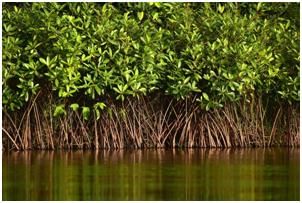
Shreya plucked a lotus plant from a pond near her house. She observed that it has a long hollow stem. Can you explain the function of the stem?
- a)To help leaves float on water
- b)To absorb soil
- c)To fix the plant to the bottom of the pond
- d)To make the flower beautiful
Correct answer is option 'A'. Can you explain this answer?
Shreya plucked a lotus plant from a pond near her house. She observed that it has a long hollow stem. Can you explain the function of the stem?
a)
To help leaves float on water
b)
To absorb soil
c)
To fix the plant to the bottom of the pond
d)
To make the flower beautiful
|
|
Sudhir Mehta answered |
The stems in lotus plants are hollow and very light. This helps the leaves to float on water.
Which of these is of great importance in nature as it helps plants to make their own food in the presence of sunlight?- a)Oxygen
- b)Chlorophyll
- c)Carbon monoxide
- d)Iodine solution
Correct answer is option 'B'. Can you explain this answer?
Which of these is of great importance in nature as it helps plants to make their own food in the presence of sunlight?
a)
Oxygen
b)
Chlorophyll
c)
Carbon monoxide
d)
Iodine solution
|
|
Pranav Singh answered |
- Chlorophyll is essential for plants to synthesize its food.
- Plants use Chlorophyll and light to make food.
- Chlorophyll gives green colour to plants.
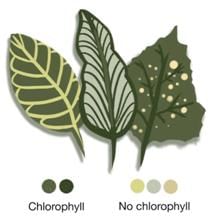
What does a habitat provide for an organism?- a)Predators to challenge survival
- b)Unfavorable living conditions
- c)Everything it needs to survive
- d)Limited space for growth
Correct answer is option 'C'. Can you explain this answer?
a)
Predators to challenge survival
b)
Unfavorable living conditions
c)
Everything it needs to survive
d)
Limited space for growth

|
Nclex Coaching Centre answered |
A habitat provides everything an organism needs to survive, including food, water, shelter, and appropriate living conditions. For plants, this means having the necessary resources to grow and reproduce, even in varied and extreme environments like deserts, mountains, and underwater regions. Adaptations help plants thrive in these diverse habitats.
In cactus plants, photosynthesis occurs in- a)leaves.
- b)spines.
- c)roots.
- d)stems.
Correct answer is option 'D'. Can you explain this answer?
In cactus plants, photosynthesis occurs in
a)
leaves.
b)
spines.
c)
roots.
d)
stems.
|
|
Sudhir Mehta answered |
In cactus plants, photosynthesis occurs in its thick and fleshy stems.
Which of the following is an example of plant adaptation?- a)Growing faster
- b)Changing leaf color in the fall
- c)Using thorns to scare off animals
- d)Releasing fragrance during the day
Correct answer is option 'C'. Can you explain this answer?
a)
Growing faster
b)
Changing leaf color in the fall
c)
Using thorns to scare off animals
d)
Releasing fragrance during the day
|
|
Kavya Basak answered |
Understanding Plant Adaptation
Plant adaptation refers to the changes that plants undergo to survive in their environments. These adaptations help them deal with challenges such as harsh weather, limited water, and threats from herbivores.
Why Option C is Correct
- Using Thorns for Protection:
One of the most effective adaptations plants have developed is the use of thorns. These sharp structures serve as a defense mechanism to deter animals from eating them. By scaring off potential herbivores, plants increase their chances of survival and reproduction.
- Examples of Plants with Thorns:
- Cacti: Many cacti have thorns that not only protect them from animals but also reduce water loss by providing shade.
- Roses: Rose bushes have thorns that prevent animals from munching on their leaves and flowers.
Why Other Options Are Not Adaptations
- Growing Faster:
While growing faster can be beneficial, it is not a specific adaptation to a threat. Instead, it is a general growth response to environmental conditions.
- Changing Leaf Color in the Fall:
This is a seasonal change that helps plants prepare for winter, but it is not a defensive adaptation against threats.
- Releasing Fragrance During the Day:
While this can attract pollinators, it is not a protective adaptation aimed at survival against herbivores.
Conclusion
In summary, using thorns to scare off animals is a clear example of plant adaptation as it directly impacts the plant's ability to survive and thrive in its environment.
Plant adaptation refers to the changes that plants undergo to survive in their environments. These adaptations help them deal with challenges such as harsh weather, limited water, and threats from herbivores.
Why Option C is Correct
- Using Thorns for Protection:
One of the most effective adaptations plants have developed is the use of thorns. These sharp structures serve as a defense mechanism to deter animals from eating them. By scaring off potential herbivores, plants increase their chances of survival and reproduction.
- Examples of Plants with Thorns:
- Cacti: Many cacti have thorns that not only protect them from animals but also reduce water loss by providing shade.
- Roses: Rose bushes have thorns that prevent animals from munching on their leaves and flowers.
Why Other Options Are Not Adaptations
- Growing Faster:
While growing faster can be beneficial, it is not a specific adaptation to a threat. Instead, it is a general growth response to environmental conditions.
- Changing Leaf Color in the Fall:
This is a seasonal change that helps plants prepare for winter, but it is not a defensive adaptation against threats.
- Releasing Fragrance During the Day:
While this can attract pollinators, it is not a protective adaptation aimed at survival against herbivores.
Conclusion
In summary, using thorns to scare off animals is a clear example of plant adaptation as it directly impacts the plant's ability to survive and thrive in its environment.
Which of the following statements is FALSE regarding hilly trees like the Pine?- a)They do not have flowers.
- b)They are dome shaped.
- c)They are conifers.
- d)Their leaves are needle-shaped.
Correct answer is option 'B'. Can you explain this answer?
Which of the following statements is FALSE regarding hilly trees like the Pine?
a)
They do not have flowers.
b)
They are dome shaped.
c)
They are conifers.
d)
Their leaves are needle-shaped.
|
|
Jyoti Gupta answered |
Understanding Hilly Trees like Pine
Hilly trees, particularly pines, are fascinating plants that exhibit unique characteristics. Let's analyze the statements provided to identify which one is false.
Statement Analysis
- a) They do not have flowers.
- This statement is true. Pines are gymnosperms, meaning they reproduce using cones instead of flowers.
- b) They are dome shaped.
- This statement is false. While some trees may have a dome shape, pines typically have a more conical or pyramidal shape, especially when they are young. Their branches extend outward and upward, creating a distinctive silhouette that is not dome-like.
- c) They are conifers.
- This statement is true. Pines belong to the conifer family, which means they bear cones and have needle-like leaves.
- d) Their leaves are needle-shaped.
- This statement is also true. Pine trees have long, slender leaves that resemble needles, which help reduce water loss and withstand cold climates.
Conclusion
In summary, the false statement among the options is that hilly trees like pines are dome-shaped. Instead, they have a conical shape, making them easily recognizable in forests and hilly areas. Understanding these characteristics helps us appreciate the adaptability and beauty of pine trees in their natural habitats.
Hilly trees, particularly pines, are fascinating plants that exhibit unique characteristics. Let's analyze the statements provided to identify which one is false.
Statement Analysis
- a) They do not have flowers.
- This statement is true. Pines are gymnosperms, meaning they reproduce using cones instead of flowers.
- b) They are dome shaped.
- This statement is false. While some trees may have a dome shape, pines typically have a more conical or pyramidal shape, especially when they are young. Their branches extend outward and upward, creating a distinctive silhouette that is not dome-like.
- c) They are conifers.
- This statement is true. Pines belong to the conifer family, which means they bear cones and have needle-like leaves.
- d) Their leaves are needle-shaped.
- This statement is also true. Pine trees have long, slender leaves that resemble needles, which help reduce water loss and withstand cold climates.
Conclusion
In summary, the false statement among the options is that hilly trees like pines are dome-shaped. Instead, they have a conical shape, making them easily recognizable in forests and hilly areas. Understanding these characteristics helps us appreciate the adaptability and beauty of pine trees in their natural habitats.
Which characteristic allows Hydrilla leaves to survive underwater?- a)Broad and flat leaves
- b)Thick and fleshy leaves
- c)Thin, narrow leaves
- d)Spiny and sharp leaves
Correct answer is option 'C'. Can you explain this answer?
a)
Broad and flat leaves
b)
Thick and fleshy leaves
c)
Thin, narrow leaves
d)
Spiny and sharp leaves

|
Nclex Coaching Centre answered |
Hydrilla leaves are thin and narrow, which allows water to pass through them easily without causing damage. This adaptation helps the plant survive in the flowing water environment. Additionally, this feature prevents the leaves from tearing due to water movement, ensuring the plant remains intact.
Why do floating plants like duckweed have spongy leaves with air spaces?- a)To attract bees
- b)To store food
- c)To help them float
- d)To scare animals away
Correct answer is option 'C'. Can you explain this answer?
a)
To attract bees
b)
To store food
c)
To help them float
d)
To scare animals away

|
Nclex Coaching Centre answered |
Floating plants like duckweed have spongy leaves filled with air spaces, which help them float on the water. This makes it easier for the plant to get sunlight and stay stable on the water surface.
Which type of tree loses all its leaves in autumn to survive the winter?- a)Evergreen tree
- b)Deciduous tree
- c)Cactus tree
- d)Palm tree
Correct answer is option 'B'. Can you explain this answer?
Which type of tree loses all its leaves in autumn to survive the winter?
a)
Evergreen tree
b)
Deciduous tree
c)
Cactus tree
d)
Palm tree

|
Kds Coaching answered |

- A deciduous tree is a type of tree that loses all its leaves at once in autumn.
- This helps the tree survive the cold winter by saving water.
- In spring, new leaves grow back.
- Examples of deciduous trees include cherry and maple.
- On the other hand, evergreen trees keep their leaves all year round and do not lose them in autumn.
How do underwater plants help fish and other aquatic animals?- a)By giving shade
- b)By making food for them
- c)By releasing oxygen into the water
- d)By growing flowers
Correct answer is option 'C'. Can you explain this answer?
How do underwater plants help fish and other aquatic animals?
a)
By giving shade
b)
By making food for them
c)
By releasing oxygen into the water
d)
By growing flowers
|
|
Riya Singh answered |
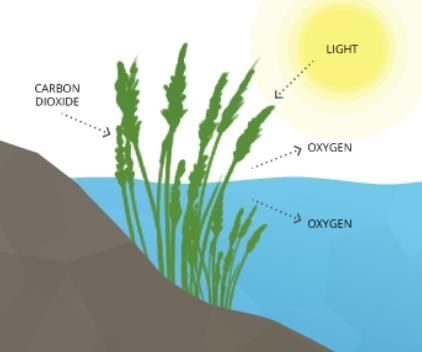
Underwater plants release oxygen into the water during photosynthesis. This oxygen is important for fish and other aquatic animals to breathe and live, helping to keep the water healthy.
Why do fixed aquatic plants have stomata on the upper side of their leaves?- a)To look pretty
- b)To save water
- c)To take in air
- d)To stay cool
Correct answer is option 'C'. Can you explain this answer?
a)
To look pretty
b)
To save water
c)
To take in air
d)
To stay cool
|
|
Riya Singh answered |
Fixed aquatic plants, such as water lilies, have stomata on the upper side of their leaves to take in air. This is important because their leaves float on the water, so having stomata on top allows them to get the carbon dioxide they need for photosynthesis.
What are plants that grow in water called?- a)Desert plants
- b)Mountain plants
- c)Aquatic plants
- d)Forest plants
Correct answer is option 'C'. Can you explain this answer?
What are plants that grow in water called?
a)
Desert plants
b)
Mountain plants
c)
Aquatic plants
d)
Forest plants

|
Kds Coaching answered |
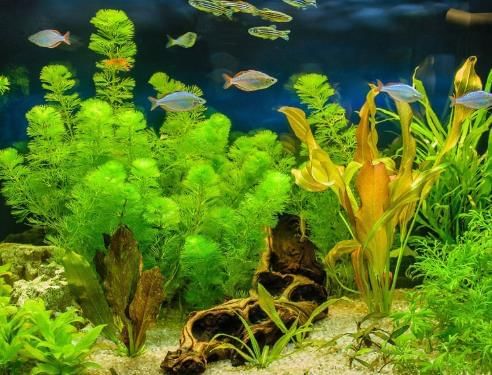
Plants that grow in water are called aquatic plants. They live in water environments like lakes, ponds, rivers, and oceans.
How do underwater plants like Hydrilla survive underwater? 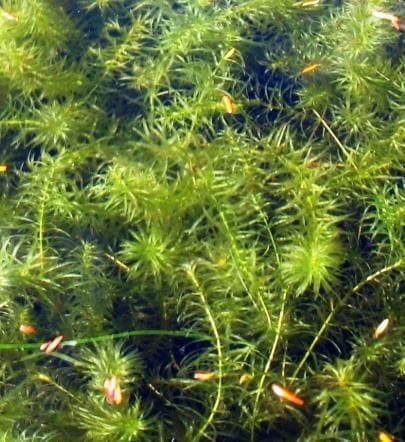
- a)By having thick, hard leaves
- b)By having broad leaves with a waxy surface
- c)By having thin, narrow leaves
- d)By growing above the water
Correct answer is option 'C'. Can you explain this answer?
How do underwater plants like Hydrilla survive underwater?

a)
By having thick, hard leaves
b)
By having broad leaves with a waxy surface
c)
By having thin, narrow leaves
d)
By growing above the water

|
Dr Manju Sen answered |
Underwater plants like Hydrilla have thin, narrow leaves that let water pass through them easily. This helps the plants stay in place and not get torn by water movement.
What helps fixed aquatic plants like water lilies stay afloat?- a)Long, deep roots
- b)Thick, woody stems
- c)Broad, waxy leaves
- d)Spiny leaves
Correct answer is option 'C'. Can you explain this answer?
a)
Long, deep roots
b)
Thick, woody stems
c)
Broad, waxy leaves
d)
Spiny leaves
|
|
Glitz Classes answered |
Fixed aquatic plants, like water lilies, have broad leaves with a waxy surface that helps them float on the water. The waxy coating keeps the leaves dry and prevents them from rotting.
Chapter doubts & questions for Plants - Science for Grade 4 2025 is part of Grade 4 exam preparation. The chapters have been prepared according to the Grade 4 exam syllabus. The Chapter doubts & questions, notes, tests & MCQs are made for Grade 4 2025 Exam. Find important definitions, questions, notes, meanings, examples, exercises, MCQs and online tests here.
Chapter doubts & questions of Plants - Science for Grade 4 in English & Hindi are available as part of Grade 4 exam.
Download more important topics, notes, lectures and mock test series for Grade 4 Exam by signing up for free.
Science for Grade 4
25 videos|44 docs|24 tests
|

Contact Support
Our team is online on weekdays between 10 AM - 7 PM
Typical reply within 3 hours
|
Free Exam Preparation
at your Fingertips!
Access Free Study Material - Test Series, Structured Courses, Free Videos & Study Notes and Prepare for Your Exam With Ease

 Join the 10M+ students on EduRev
Join the 10M+ students on EduRev
|

|
Create your account for free
OR
Forgot Password
OR
Signup to see your scores
go up within 7 days!
Access 1000+ FREE Docs, Videos and Tests
Takes less than 10 seconds to signup









